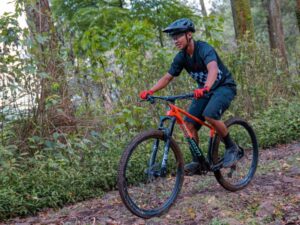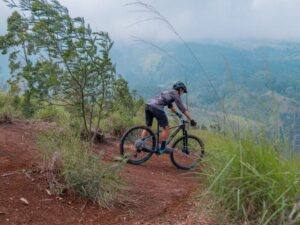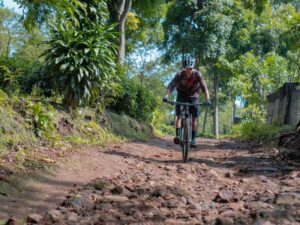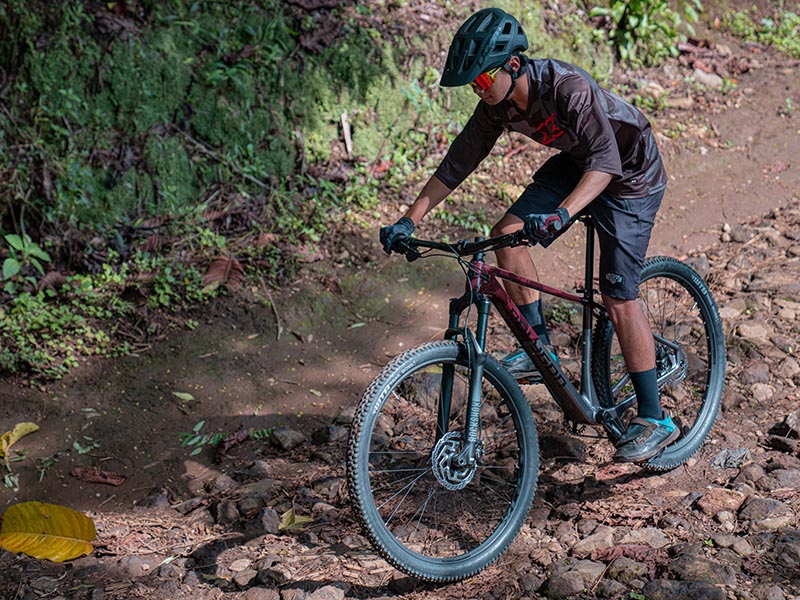Most people enjoy cycling because it’s easy to manage once they got the grip on balancing the wheels and taking turns smoothly. However, cycling is not only about smooth pedaling ability and staying upright. There are more skills to help you sharpen your cycling accuracy and endurance, especially when you’re aiming to compete or taking cycling as a serious hobby. Here are 5 basic cycling skills to master:
1. Pedaling

Pedaling comes easy because it’s the core skill to ride a bike. Meanwhile, when done effectively, pedaling technique can help you to optimize your speed with less effort and minimize injury possibilities. Mastering effective pedaling skills can be done by simple practices such as controlling your pedal when pulling on the upstrokes, concentrating on pedaling with only one leg at a time while you’re out on the road, or setting a long route. When you’re adjusting to efficient pedaling you no longer need to rely on quadriceps muscles to gain power but also learn how to activate the hamstrings, glutes, and calves to accommodate better-pedaling skills.
Getting your bike set up correctly, including saddle height and fore-aft adjustment is a prerequisite for a smooth pedal stroke. If the saddle is too high, you’re not going to be able to drive your heel effectively. Meanwhile, if it’s too low, it will cause knee pain. The ideal position is to knee over the ball of your foot with the pedal at 3 o’clock, with the knee slightly bent with the pedal at 6 o’clock.
2. Shifting

Shifting can be tricky to some since you have to sense the right moment for which gear you need on a certain route. A shifting rule of thumb for you: to shift onto a different chainring/gear up front, use your left shifter. Meanwhile, you can use your right shifter to shift the rear gear. You’re going to shift your right shifter more often than the left one.
So, when is the “right moment” for shifting? While riding along the flat road, it’s easier to move up to the big chainring to accelerate the speed, on the other hand, it’s easier to move to the smaller chainring when climbing up to provide lighter pedaling and save power effectively. When approaching a hill or change in terrain, make sure you’re already switching to the right gear since it’ll be harder to switch the gear when you’re already on the climb. Avoid pushing hard or stop pedaling completely when shifting, as it will cause the chain skips or falls off.
Here are some terms that you need to know for shifting: when your bike is on the smallest chain ring in the front and largest cog on your cassette (rear gears), you can say it as “easy” or “low” gear. This setting will enable you to move easier while climbing. To get into this setting, you will need to “downshift” your bike. Otherwise, when your bike is on the largest chain ring in front and the smallest cog on your cassette, you can say it as “hard” or “high” gear.
You can improve your shifting skill by practicing switching small chainring back and forth when riding to increase sensitivity in switching timing and knowing which gear is appropriate to apply in certain routes.
3. Braking

Braking is easy yet hard to master because when it’s done inappropriately, it could cause injury and harm other riders. When speeding at a certain level, you have to be aware of your surroundings and pull the correct brake when you need to stop the bike.
The front brake is used when you’re trying to slow down the speed, however, it is not recommended to use only the front brake when you’re on a high speed because it can send you over the bars due to its high stopping power. The rear bike is not as powerful as the front bike but is quite helpful to use when you need to make a sudden stop. However, using only the rear bike can cause you to slip over and lose balance over your bike. It’s better to combine both brakes to stop your bike safely.
You should use both the front and rear brakes and sit well down on the saddle, putting your weight over the back wheel to stabilize the bike to achieve controlled braking. Release the brakes a little before re-applying the brake if you feel the bike skidding.
Learning how to feather your brake is also important. Feathering is a technique of lightly and rapidly alternating pressure and releasing the brake to prevent brakes from locking while controlling speed. Some other benefit of feathering includes preventing the wheel rims to overheat on long descents.
It is important to familiarize yourself with how your brakes work under different conditions. As you ride, you will get to know how long it takes and how much ground you cover before coming to a stand-still from different speeds and visualize using your brakes in an emergency.
4. Descending

When it comes to downhill rides at high speed, it’s important to combine your balance and braking skills to increase your biking performance. Cycling at steep and winding routes requires agility and flexible control to make balancing easier. Try to control your bike by keeping your weight over your saddle and using the drops to lower your center of gravity. In addition, try not to put too much pressure on your hands and shoulders to keep them from fatiguing and tensing muscles.
The simple practice to help you increase your descending skill is trying to go around sharp corners in your neighborhood. You can practice how to control your speed, navigate your bike with drops, and take sharp turns by leaning on your bike to increase your flexibility. Another way to learn is to follow a more experienced rider, mimic their body position, and look well at the road ahead of them to predict the line they will take.
Remember, it is important to be aware of your surroundings while riding on the descending road. Try to avoid hazards such as painted white lines, wet drain covers, speed bumps, and gravel and fallen leaves.
5. Balance

Keeping the balance when cycling usually comes along as you increase your riding frequency. To improve your balance, try to ride along various routes and corners. Try to be confident to look down on the road, then practice looking back while going straight to improve concentration.
It’s also a good practice to improve your balance by controlling your speed when riding. Ride slow as an exercise. Most cyclist finds it hard to keep their balance at a slow speed, cone drills can be a good practice to increase your balance skill. The cone drills are done by narrowing the gap between cones and trying to get through them without knocking them down. Cycling slowly makes the body will get your body used to balancing without resorting too much to steer.
The technical thing that you need to consider to improve your balance is your bike setting. If you’re riding in a more upright position, the position will help you to improve your balance. Also, consider having core exercises to be more fit and balanced.
The certain route requires certain tricks to get through. By having these five skills to master, it’s easier to adapt to various environment that requires specific skills to tackle and manage your stamina effectively in order not to easily drown out during the journey.
